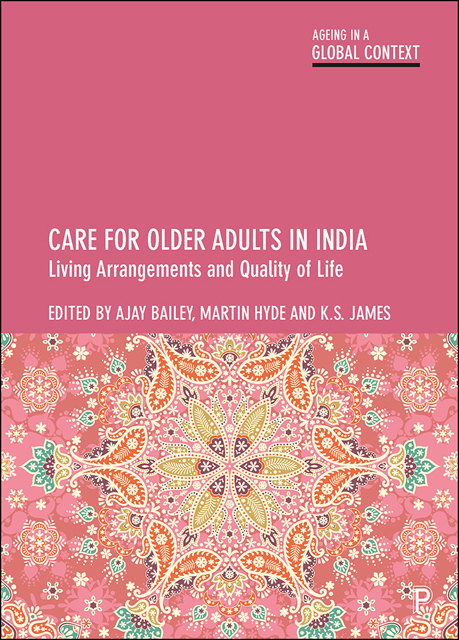Book contents
- Frontmatter
- Contents
- List of figures and tables
- Notes on the editors
- List of contributors
- Acknowledgements
- Series editors’ preface
- Map of India
- 1 Introduction: Living arrangements and care in India
- 2 Theorising care and relationships in the age of migration
- 3 Emerging living arrangements of older adults in India: patterns and welfare implications
- 4 Living arrangement concordance and the well-being of older persons in India
- 5 Family size and living arrangements among older adults in Kerala: panel data analysis, 2004– 19
- 6 Care arrangements for older adults: exploring the intergenerational contract in emigrant households of Goa, India
- 7 All my responsibilities towards my children are over! Linked lives and life course obligations among older adults with migrant children in India
- 8 Interpreting the landscapes of care for older men in Delhi and Kolkata: perspectives from care receivers and caregivers
- 9 The role of cultural meaning system and place attachment in retaining home ownership while residing in retirement homes in Kerala, India
- 10 Decision-making and choice or sine qua non? Care home entry in Tamil Nadu
- 11 Welfare and development programmes for older adults in India
- 12 Lessons and future directions for caregiving research in India
- Index
1 - Introduction: Living arrangements and care in India
Published online by Cambridge University Press: 13 October 2022
- Frontmatter
- Contents
- List of figures and tables
- Notes on the editors
- List of contributors
- Acknowledgements
- Series editors’ preface
- Map of India
- 1 Introduction: Living arrangements and care in India
- 2 Theorising care and relationships in the age of migration
- 3 Emerging living arrangements of older adults in India: patterns and welfare implications
- 4 Living arrangement concordance and the well-being of older persons in India
- 5 Family size and living arrangements among older adults in Kerala: panel data analysis, 2004– 19
- 6 Care arrangements for older adults: exploring the intergenerational contract in emigrant households of Goa, India
- 7 All my responsibilities towards my children are over! Linked lives and life course obligations among older adults with migrant children in India
- 8 Interpreting the landscapes of care for older men in Delhi and Kolkata: perspectives from care receivers and caregivers
- 9 The role of cultural meaning system and place attachment in retaining home ownership while residing in retirement homes in Kerala, India
- 10 Decision-making and choice or sine qua non? Care home entry in Tamil Nadu
- 11 Welfare and development programmes for older adults in India
- 12 Lessons and future directions for caregiving research in India
- Index
Summary
Introduction
India has one of the most rapidly ageing populations on the planet. Given the change in the size and nature of the older population in India it is imperative that we better understand the situation of older people in India. However, India is a complex and diverse country made up of different states, castes, cultures, and ethnic groups. India's older adult population has now risen to 8.57 per cent, however in states such as Goa and Kerala the percentage of older adults is as high as 11.20 per cent and 12.55 per cent respectively (Census, 2011). Recent data from the Longitudinal Ageing Study in India (LASI) show that nearly 12 per cent of older adults were 60+ and that the states of Kerala, Himachal Pradesh, and Tamil Nadu had a higher proportion of older adults (IIPS, 2020). India had, in the past, a predominantly familybased elder care system. However, rapid population ageing, the decline of extended families coupled with decreasing fertility rates, increasing life expectancy, widowhood, singlehood or strained intergenerational relationships, have all raised concerns that an increasing number of older adults in India live alone. These concerns are amplified as India, like many other lower-and middle-income countries, is still struggling in setting up social security and pensions systems (Arokiasamy and Yadav, 2014; Giridhar et al, 2014; Bloom et al, 2015). However, as we show throughout this edited volume, the demographic picture is not uniform as Indian states are at surprisingly diverse levels of demographic transition and vary to a great extent in their cultural practices, social norms and socio-political contexts.
This chapter provides a general introduction to the topic by situating the subsequent chapters within the broad demographic trends already mentioned and gives an outline of the structure and chapters of the book. This chapter introduces the need for focus on living arrangements and care. It highlights the social, economic and cultural contexts that shape the provision of care for older adults. We link the different studies presented and explore the consequences of changing living arrangements on long-term care, and the economic, physical, social and psychological well-being of older people.
- Type
- Chapter
- Information
- Care for Older Adults in IndiaLiving Arrangements and Quality of Life, pp. 1 - 11Publisher: Bristol University PressPrint publication year: 2022



